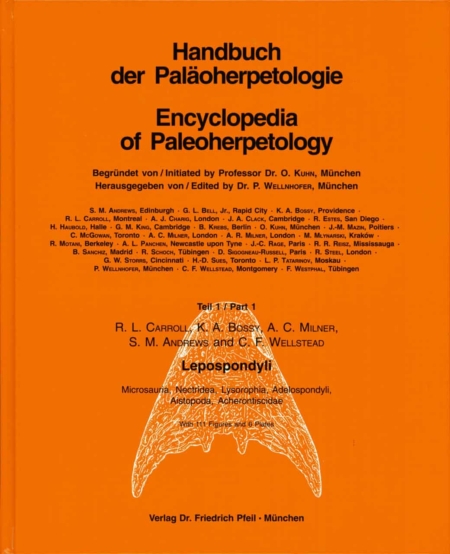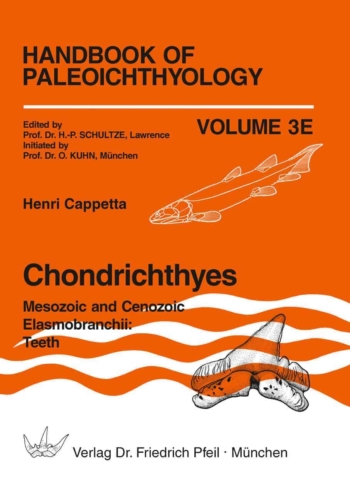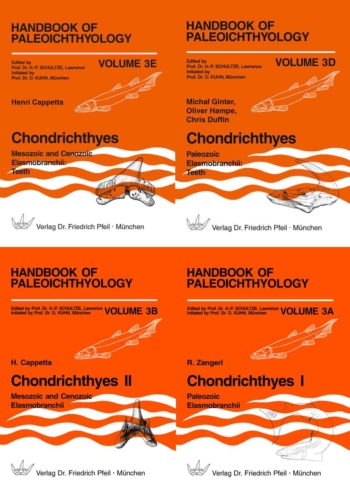This volume includes descriptions of a number of amphibian groups commonly referred to as lepospondyls. Three groups, now considered as orders, have long been included among the lepospondyls: the microsaurs, the nectrideans, and the aïstopods. Two clearly distinct families, the Lysorophidae and Adelogyrinidae, have been associated with the microsaurs or treated as separate groups within the lepospondyls. They are here placed in separate orders. The lepospondyls encompass a wide variety of small animals that differentiated near the base of the Lower Carboniferous and persisted for at least 75 million years, to the end of the Lower Permian. Together they show more anatomical diversity than do all the living amphibian orders. Despite the many autapomorphies of the individual groups, recent phylogenetic analysis does support a common ancestry of the lepospondyl orders.
HPH 1 • Lepospondyli
1998. [in English] – 216 pp., 111 figures, 6 plates.
25.5 x 20.5 cm, Hard cover.
Series: Handbook of Paleoherpetology
100,00 €
plus shipping costs
Foreword (P. WELLNHOFER) ... V
Preface ... VI
Acknowledgements ... VII
Institutional Abbreviations ... VIII
Figure Abbreviations ... IX
Order Microsauria (R. L. CARROLL)
Introduction ... 1
Characteristics of Microsaurs ... 1
History of the Microsaur Concept ... 2
Taxonomy ... 4
Comparative Osteology ... 6
Skull ... 6
Vertebrae and Ribs ... 18
Appendicular Skeleton ... 22
Scales and other dermal Ossifications ... 32
Systematic Review ... 34
Suborder Tuditanomorpha CARROLL and GASKILL 1978 ... 34
Family Tuditanidae COPE 1875 ... 34
Family Hapsidopareiontidae DALY 1973 ... 39
Family Pantylidae CASE 1911 ... 42
Family Gymnarthridae CASE 1919 ... 42
Family Ostodolepidae ROMER 1945 ... 50
Family Trihecatontidae VAUGHN 1972 ... 51
Family Goniorhynchidae CARROLL and GASKILL 1978 ... 54
Suborder Microbrachomorpha CARROLL and GASKILL 1978 ... 54
Family Microbrachidae FRITSCH 1883 ... 54
Family Hyloplesiontidae CARROLL and GASKILL 1978 ... 56
Family Brachystelechidae CARROLL and GASKILL 1978 ... 58
Family Odonterpetontidae CARROLL and GASKILL 1978 ... 65
Family undesignated ... 66
Specimens questionably assigned to the Microsauria ... 67
Genera incorrectly assigned to the Microsauria ... 67
Biology ... 68
Geographical Distribution ... 71
Order Nectridea (K. A. BOSSY and A. C. MILNER)
Introduction ... 73
Museum Abbreviations ... 73
Taxonomic History ... 74
Index of Taxa ... 76
Comparative Osteology ... 76
Skull ... 76
Postcranial Skeleton ... 88
Appendicular Skeleton ... 94
Dermal Scales ... 103
Functional Morphology ... 105
Life History and Growth ... 108
Systematic Review ... 109
Family Urocordylidae LYDEKKER 1889 ... 109
Family Diplocaulidae COPE 1881 ... 122
Family Scincosauridae JAEKEL 1909 ... 128
Nectridea incertae sedis ... 130
Rejected and reidentified Taxa ... 131
Ichnotaxa ... 131
Order Lysorophia (C. F. WELLSTEAD)
Introduction ... 133
Historical Review ... 133
Anatomy of the Lysorophia ... 135
Skull ... 135
Vertebrae and Ribs ... 140
Appendicular Skeleton ... 142
Systematic Review ... 143
Family Cocytinidae COPE 1875d ... 143
Lysorophia incertae sedis ... 144
Habitus ... 145
Geological and Geographical Distribution ... 146
Phylogenetic Relationships of Lysorophoids ... 147
Order Adelospondyli (R. L. CARROLL and S. M. ANDREWS)
Introduction ... 149
Taxonomic History ... 149
Comparative Osteology ... 150
General appearance of Skull ... 150
Postcranial Skeleton ... 155
Appendicular Skeleton ... 159
Systematic Review ... 160
Family Adelogyrinidae BROUGH and BROUGH 1967 ... 160
Relationships ... 161
Mode of Life and Environment ... 161
Order Aïstopoda (R. L. CARROLL )
Introduction ... 163
Taxonomic History ... 164
Comparative Osteology ... 165
Skull ... 165
Vertebrae and Ribs ... 174
Appendicular Skeleton ... 174
Systematic Review ... 179
Family Lethiscidae WELLSTEAD 1982 ... 179
Family Ophiderpetontidae SCHWARZ 1908 ... 179
Family Phlegethontiidae COPE 1875 ... 181
Aïstopoda incerti sedis ... 182
Order undesignated (R. L. CARROLL)
Family Acherontiscidae CARROLL 1967 ... 183
Systematic Review ... 185
Family Acherontiscidae CARROLL 1967 ... 185
Summary (R. L. CARROLL)
Geological and Geographical Distribution ... 187
Interrelationships ... 190
Bibliography ... 206
Index of Genera and higher Taxa ... 213
This volume will include descriptions of a number of amphibian groups commonly referred to as lepospondyls. This term was coined by ZITTEL (1888) to include Paleozoic amphibians in which the notochord was persistent and enclosed in constricted bony cylinders, hourglass-shaped in longitudinal section and in which the teeth were simple (without labyrinthine infolding), conical and hollow.
The lepospondyls encompass a wide variety of small animals that differentiated near the base of the Lower Carboniferous and persisted for at least 75 million years, to the end of the Lower Permian. Together they show more anatomical diversity than do all the living amphibian orders, including a number of elongate, limbless lineages, families that resemble terrestrial salamanders and lizards, and many genera that are without parallels among any other groups, fossil or living.
Three groups, now considered as orders, have long been included among the lepospondyls: the microsaurs, the nectrideans, and the aïstopods. Two clearly distinct families, the Lysorophidae and Adelogyrinidae, have been associated with the microsaurs or treated as separate groups within the lepospondyls. They are here placed in separate orders. One poorly known genus, Acherontiscus, is the only form that combines significant features of labyrinthodonts and lepospondyls. It cannot be determined whether it is a relict of an early stage in the evolution of lepospondyls or if this genus represents a separate lineage that convergently evolved some lepospondyl characteristics. In addition to the characters used by ZITTEL to differentiate lepospondyls from the other major assemblage of Paleozoic amphibians, the labyrinthodonts, all lepospondyls (excluding Acherontiscus) are characterized by the presence of a single, cylindrical vertebral centrum that is specialized for articulation with the skull, the absence of a squamosal embayment at the posterior margin of the skull, and the absence of paired fangs and replacement pits on the palate. Use of the term Lepospondyli implies that these groups evolved from a common ancestor in which these features were already present. As yet, this cannot be directly documented from fossil evidence. No species has been recognized as a plausible common ancestor of the lepospondyl orders. Details of cranial anatomy, the general body form, and presumed ways of life of the various groups are very distinct, and even the earliest members of each order are highly specialized and show little evidence of having evolved from a common pattern.
Despite the many autapomorphies of the individual groups, recent phylogenetic analysis does support a common ancestry of the lepospondyl orders (LAURIN and REISZ, 1997; CARROLL, 1995). On the other hand, sister-group relationships with other known Paleozoic tetrapods remain controversial. None of the other groups of Carboniferous amphibians have been described from beds older than those containing the oldest lepospondyl, which already shows most of the unique derived features that characterize the known orders. There is no evidence that these characters were shared by early members of any other tetrapod group. Lepospondyls do share derived skull and limb features in common with primitive temnospondyls and anthracosaurs, to the exclusion of Devonian tetrapods and Crassigyrinus, but show a clearly divergent pattern of the articulation between the occiput and the first cervical vertebra and the anatomy of the first cervical. Together, the distribution of these characters suggests the divergence of a separate lineage leading to the lepospondyls, near the base of the assemblage including anthracosaurs and temnospondyls.
Loss of the squamosal embayment, palatal fang and pit pairs, and labyrinthine enfolding of the dentine, as well as reduction in the number of bones of the dermal skull roof, are all shared with early amniotes. All of these characters may be attributed to small skull size and are not necessarily indicative of close relationships. Other features of the skull, the configuration of the cervical and trunk vertebrae, and limb structure support close affinities of amniotes with anthracosaurs (specifically the diadectomorphs), rather than to the lepospondyls. Nevertheless, phylogenetic analysis of a much larger number of characters among all Paleozoic tetrapods supports a sister-group relationship between lepospondyls and amniotes (including diadectomorphs).
Lepospondyls may also be implicated in the origin of some or all of the modern amphibian orders. LAURIN and REISZ’s (1997) phylogenetic analysis places caecilians, urodeles, and anurans as a succession of derived lineages nested within the Lepospondyli, and earlier studies had suggested close affinities of caecilians and salamanders with the microsaurs. Clearly, an understanding of the diversity and anatomy of lepospondyls is vital to any study of the origin of the modern amphibians, as well as for an appreciation of the pattern of evolution of early land vertebrates.
You must be logged in to post a review.
"*" indicates required fields
We’re here for you
Verlag Dr. Friedrich Pfeil
Hauptstraße 12B
5232 Bergkirchen OT Günding – Germany
Tel.: +49 8131 61 46 590
Fax: +49 8131 61 46 591
E-Mail: info@pfeil-verlag.de
Contact
Tel.: +49 89 742827-0
Fax: +49 89 7242772
E-Mail: info@pfeil-verlag.de






Reviews
There are no reviews yet.